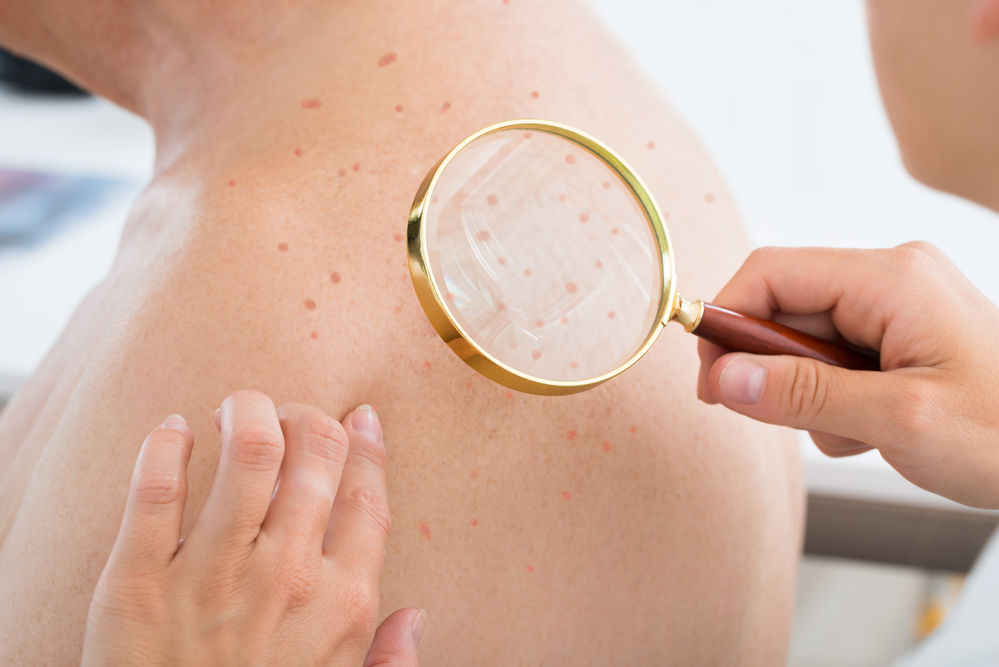
If you’ve been diagnosed with skin cancer, your treatment options will depend on the size, type, and location of the lesion. For some patients, Mohs Surgery is an option. This highly specialized procedure will remove the skin cancer while leaving as much healthy tissue behind as possible, making it a good option for treating places like the face and nose. It’s one of the many skin cancer treatments offered at Dundee Dermatology in West Dundee, IL.
What Is Mohs Surgery?
Mohs Surgery is performed under local anesthesia. Your doctor will begin by cutting out the visible skin issue. Next, a thin layer of skin around the site will be removed and will be examined under a microscope to determine if cancer cells exist. If cancer cells are found, another thin layer of skin will be removed. This process will continue until your doctor is confident that no cancer cells remain. While each layer of skin is examined, you’ll be bandaged and can wait comfortably in the treatment room. After surgery, the wound may be closed with a graft, or in some cases, it may be allowed to heal on its own.
What Are the Advantages?
One of the biggest advantages associated with this type of treatment is that it is highly effective. The other big advantage is that because it removes only skin with cancer cells, the patient is left with more healthy tissue than some other types of treatment. This makes Mohs Surgery a popular option in treating cancers on the face, where scarring is a concern for some patients.
What Post-Operative Instructions Are Given for Mohs?
We ask patients to leave the surgical dressing dry and in place for 24 hours. Tylenol or ibuprofen can be taken on an as-needed basis. We also suggest the intermittent use of an ice pack on the treatment area for the first 24 to 48 hours. Before you leave our office after the surgery, you’ll be given detailed instructions on caring for the surgical site.
When Is This Surgery Recommended?
Mohs Surgery is commonly used to treat two types of skin cancer: basal cell carcinoma and squamous cell carcinoma. It is usually recommended when these types of cancerous lesions are large or aggressive, or when they appear in an area of the body that has little underlying tissue, such as on the eyelid or hand. This surgery may also be used to treat skin cancer that has returned after previous treatment. The most serious type of skin cancer, melanoma, can only be treated with Mohs when the lesion is in its earliest stage and when it is a specific type of melanoma that stays near the skin’s surface.
What Other Treatment Options Are Available?
Your doctor will work with you to determine the best form of treatment for your skin cancer. The type of cancer you have, as well as the nature of the lesion and its location on the body, will influence what options are available for you. Other possible treatment options include excisional surgery, freezing, chemotherapy, and photodynamic therapy.
Excisional Surgery
This treatment option involves cutting out, or excising, the lesion and some of the surrounding healthy skin.
Freezing
Small, early-stage cancerous lesions can sometimes be frozen with liquid nitrogen. The dead tissue and cancer cells then slough off as the area thaws.
Chemotherapy
Chemotherapy relies on drugs to kill cancer cells. Chemotherapy creams and lotions can be regularly applied directly to the skin by the patient at home to address cancers that have not progressed beyond the very top layer of the skin.
Photodynamic Therapy
This type of treatment kills off cancer cells with a combination of laser light and drugs. The drugs are activated by certain kinds of light.
How Will My Skin Cancer Be Diagnosed?
Your doctor will begin by visually examining your skin. Cancerous lesions commonly appear as abnormal pink or brown spots. A mole that is changing in appearance may also be a sign of skin cancer. Any areas of skin that look suspicious may be biopsied, which means a small sample of skin is excised for testing. A biopsy can determine whether or not you have skin cancer and which of the three types of skin cancer it is.
What Can I Do to Prevent Skin Cancer?
There are a number of steps you can take to avoid skin cancer. Limiting your exposure to harmful UV rays, both by staying out of the sun between 10 am and 4 pm and by covering up with long-sleeved shirts and hats, is an important preventative step. Avoiding tanning beds and sunburns is also a way of protecting your skin. Wearing sunscreen and making an annual appointment with your dermatologist for a skin cancer screening are crucial components of skin cancer prevention.
Our Practice
From its high cure rate to the minimal tissue disruption it causes, Mohs Surgery has a lot to offer. If you’ve been diagnosed with skin cancer, our practice can work with you to determine whether or not this type of surgery is a viable treatment option. If you’re concerned about a suspicious lesion on your skin, or if it’s simply time for your annual skin cancer screening, call Dundee Dermatology in West Dundee, IL. We proudly serve patients throughout the Chicago area, including those in Elgin, South Elgin, West Dundee, Carpentersville, Algonquin, Lake in the Hills, Huntley, St Charles, and Geneva.
